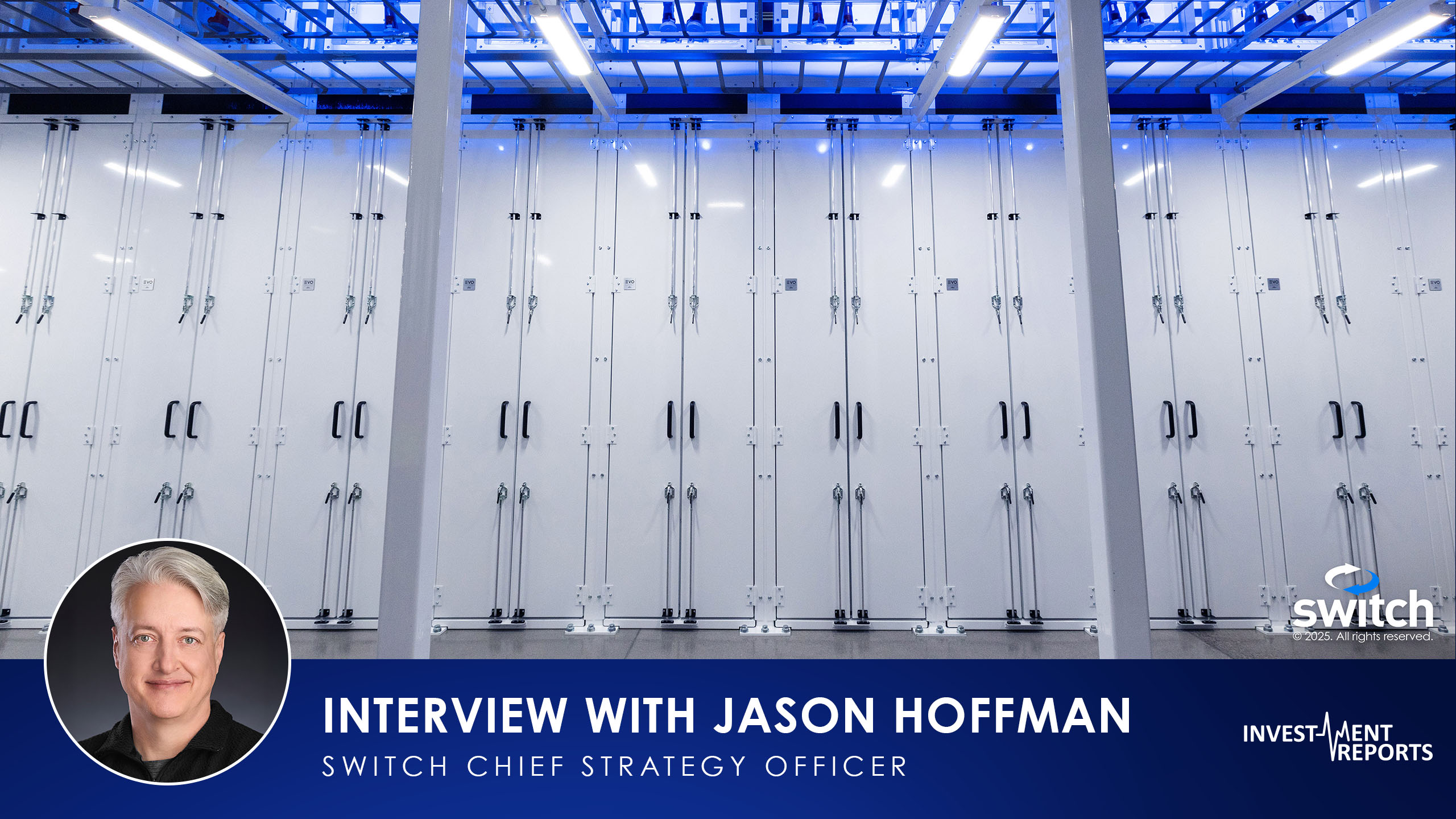What is Switch, and what is your role within the company?
Switch is a U.S.-based data center designer, builder, and operator, with a history of more than 26 years in the industry. We specialize in large-scale data center campuses that are often built on thousands of acres and support gigawatt-level capacities. Our expertise goes beyond simply constructing buildings—we are focused on creating and running highly integrated and scalable infrastructure that powers some of the most advanced technology in the world.
In terms of my role, I work with our CEO on the strategic direction of the company and its people to ensure that our long-term vision aligns with the needs of our clients. From the start, our campuses were designed to serve the most demanding workloads in the industry. That scale has become even more critical with the rise of AI, and it’s where Switch has always differentiated itself: delivering infrastructure capable of meeting the most demanding requirements.
We know Switch has developed AI-focused data centers: how are they designed to support the full AI lifecycle, from data ingestion to large-scale inference?
Switch has always been ahead in managing high-density workloads. Our founder, Rob Roy, pioneered designs such as isolated hot aisles with plenum roofing more than two decades ago, these are now widely adopted across the industry. These innovations allowed us to handle very high-density clusters long before AI became mainstream. For instance, when NVIDIA’s H100 GPUs were still air-cooled, we were among the first to deploy them at scale.
More recently, we redesigned our facilities to function almost like individual “refrigerator chambers” at the rack level. This approach enables cooling capacity of more than two megawatts per rack, giving us the flexibility to host world-first deployments like liquid-cooled H100s, B100s, GB200s and GB300s. Our ability to consistently host these cutting-edge systems comes from designing infrastructure that can evolve in tandem with technological advances.
Switch has expanded into new markets, including Austin and Atlanta. What drives these decisions on where to build next?
Our headquarters and largest footprints are in Nevada, where we have developed unique capabilities as both a data center operator and an unregulated utility under a designation called 704B. This allows us to go beyond data center development: we also handle infrastructure like networks, substations, transmission lines, and even power generation. That integrated approach is a hallmark of Switch, because we don’t just build facilities; we build the infrastructure ecosystems around them.
When we expand, we look for markets where we can make the same long-term investments. In Atlanta, for example, we’re partnering within a co-op region that allows us to co-develop generation capabilities alongside the data centers. Our goal isn’t to drop in a single building and leave. Instead, we want to create campuses that operate like batteries for the local grid: able to generate, distribute, and stabilize power while contributing to the community. That holistic vision helps us establish strong relationships with local and state governments wherever we go.
You secured $20 billion in sustainable financing since 2024. How does this funding align with your strategic goals, particularly in expanding AI-focused data centers and operational efficiency?
Capital is the oxygen of any business, and the scale of today’s buildout is truly unprecedented. To put it in perspective, the last time the U.S. saw this level of power infrastructure expansion was with the rise of air conditioning and refrigeration. What AI is driving today is of a similar scale. That’s why sustainable financing is critical—it allows us to accelerate expansion while staying true to our efficiency and sustainability goals.
This funding ensures we can continue hosting the most advanced AI systems while building responsibly. It gives us the capacity to develop more campuses, integrate next-generation cooling and power solutions, and pursue sustainability initiatives that match the scale of growth. With this capital, it is possible to keep pace with both customer demand and our own commitment to environmental stewardship.
Even with such financing, are there challenges capital alone cannot address?
Yes. While capital is abundant, not all of it is stable. A significant portion of investment in the AI space is speculative. Switch focuses on the investment-grade portion of the market. Our customers are Fortune 500 companies and hyperscalers who need to build large-scale, long-term facilities as part of their core AI strategies. That stability is what allows us to make long-term infrastructure commitments.
Another challenge is ensuring that capital translates into projects that meet the specific requirements of this rapidly evolving space. It’s not simply about pouring money into buildings. It’s about designing campuses with the density, resilience, and sustainability to support workloads that didn’t even exist five years ago. Addressing those demands requires innovation and technical expertise.
How does liquid cooling and energy-efficient designs fit into your strategy?
We’ve always emphasized sustainable design, and liquid cooling is a major advancement. Cooling with liquid is thousands of times more efficient than just cooling with air, especially for high-density AI systems. That said, air will always play a role, but the heavy lifting is done by liquid systems designed to operate in closed loops. This means once the system is charged, water usage is effectively zero: an important factor in reducing environmental impact.
Beyond cooling, our collaborations with utility providers allow us to manage our energy sources. We can buy, sell, and even generate power to work towards long-term sustainability. This flexibility means we can invest in projects that align with both community needs and our operational demands.
As AI demand grows, what challenges and opportunities do you foresee for Switch?
One of the current technical challenges is power distribution. While liquid cooling addresses heat, the next frontier is figuring out how to deliver power efficiently at extreme densities. We’re talking about a hundredfold increase in density, where a gigawatt campus that once required over a thousand acres can now fit within just ten. Designing safe and reliable systems at that scale requires entirely new approaches to the power chain.
To put this in perspective, imagine a university campus like UCLA occupying 800 acres. Now compress that into one-quarter of the space, yet consuming as much power as the entire city of Los Angeles.
That’s the reality of AI clusters today: single facilities and campuses matching or exceeding the energy footprint of major cities. It’s both a huge challenge and an opportunity for Switch to lead in designing infrastructure for this new reality.
Looking at the bigger picture, is U.S. infrastructure ready to support such rapid AI-driven growth?
No one is fully ‘ready’; if we were, the transition would be trivial. The real test is whether we can rise to the challenge. A useful comparison is air conditioning; over the second half of the twentieth century, cooling demand became one of the dominant forces shaping the U.S. grid, driving tens of gigawatts of new capacity to meet summer peaks. Today, AI data centers are emerging as a similarly transformative load; we are once again in the process of building on the order of tens of gigawatts of new capacity, roughly the same scale we mobilized for air conditioning, but now for AI.
The difference is who is driving it. In the twentieth century, the world’s largest companies were in oil and gas; they had little direct stake in whether the grid could handle air conditioning. Today, the companies at the top, worth trillions, are the very ones deploying AI; that alignment means unprecedented capital, urgency, and global competition are behind this buildout. The open question is not whether it is possible—we have proven we can scale at this level before; it is whether deployments will be broadly distributed or concentrated in a few nations. That choice will shape not only infrastructure, but geopolitics.
You have a background in both technology and finance – how has that shaped your leadership philosophy at Switch?
I think of everything as a product. On the technical side, our campuses and facilities are products designed for customers; they must perform, scale, and evolve. On the financial side, investors are not simply funding us; they are buying financial products with clear expectations. We manage those offerings with the same discipline as our infrastructure, making sure pipelines, platforms, and service are equally strong.
The third product is our culture. Switch is still founder-led; our founder remains directly involved in design, often hands-on. That passion permeates the company, and when we hire, we are selling our culture as much as the role itself. By treating technical products, financial products, and culture with equal importance, we unify our approach around serving people: whether they are customers, investors, or employees.
Source: InvestmentReports.co

